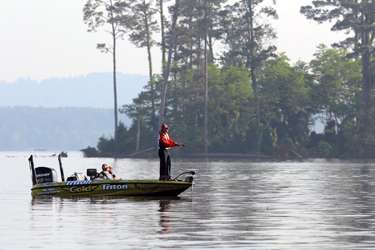
Power fishing tactics become prevalent during the fall since bass move to the shallows and feed heavily on baitfish, but there are still plenty of scenarios where finesse techniques are required.
"If I am on a man-made reservoir in the fall, without a doubt I am going to have a spinning rod and 6-pound-test line rigged up," Bassmaster Elite Series pro angler Gary Klein says. "In the fall, the water is usually clearer than it is any other time of the year. The water tables on man-made reservoirs are usually drawn down because of the summer power usage, and the boat traffic has slowed so the water really cleans up.
"When the thermocline dissipates, it really opens up a lot of the water column for the fish to use, and those fish love to suspend."
When shad wrap up in balls in creeks and river arms, Klein tempts bass near the surface with a finesse topwater trick. He opts for a LuckyCraft Sammy 65 in a ghost minnow or herring hue and walks the tiny topwater over the bait balls with a 7-foot medium Quantum PT rod and a Quantum Catalyst PT30 spinning reel.
He throws the Sammy on 10-pound SpiderWire Stealth braid when he needs to make long-distance deliveries, but he also works the topwater on 6- or 8-pound test Berkley 100% Fluorocarbon.
"It is a great bait that flicks on top like a shad and catches all three species of bass," he says.
While Klein has the most fun catching autumn bass on the tiny topwater lure, the Texas pro acknowledges that his most effective finesse tactic in the fall is "doodling" a Texas rigged small, straight-tail worm.
"That is how I won an October B.A.S.S. tournament on Bull Shoals," he said. "The lake was 30 feet low, and the water was clean. Out of the whole field, I was the only angler to catch a limit of fish all three days."
Klein caught nearly 50 keepers a day and all of the fish were holding in the 30- to 60-foot depth range. His finesse Texas rig consists of a Berkley Hand-Poured Worm matched with a 3/16-ounce slip sinker and a number 1 or 1/0 Gamakatsu wide gap hook.
His worm color choices depend on the lake he's fishing.
"My go-to color is the cinnamon brown with a blue bloodline called the Blue Crawler — that will catch them anywhere in the country," says Klein, who fishes the worm on the same rod, reel and fluorocarbon line he uses for his finesse topwater tactic. "I fish a lot of the greens and purples. Purple is the go-to color on the West Coast, but it is probably the most underrated and underused color in the Midwest."
The key to Klein's worm tactic is to determine the depth of the fish.
"This is probably one of the most crucial times of the year to have a good understanding of your electronics," Klein explains. "When you really understand your electronics, it is so easy to establish a pattern.
"You see it all (bottom contour, fish activity and how the fish are relating to cover) on your electronics."
Once Klein finds the depth of the fish, the fall rate of his lure becomes the next critical factor in his finesse presentation.
"The rate of fall will allow you to keep your lure at the right depth in the water column," he continues.
After making his cast, Klein opens the bail of his spinning reel to let the weight fall vertically and the worm spiral close behind. When Klein estimates the worm has dropped to the depth where most of the fish are holding, he holds the line with his finger and shakes the worm. As he works the lure back toward the boat, Klein feels for that telltale tick that indicates a bass has inhaled the worm.
Originally published October 2011





